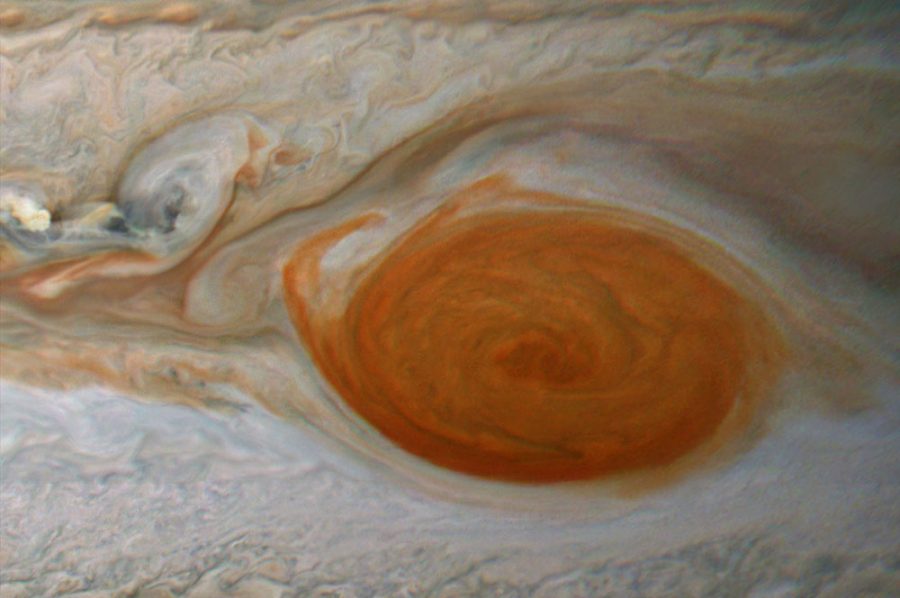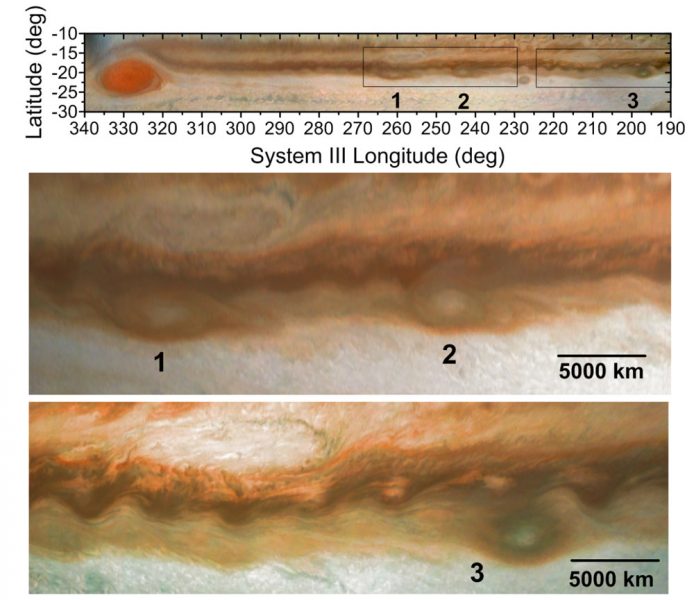“Flakes” coming off the Great Red Spot have had some wondering if this epic storm is coming to an end. But observations and computer modeling show it’s only getting stronger.

AGU / Journal of Geophysical Research: Planets
Jupiter's Great Red Spot may be off the endangered list despite shrinking ever since 1879. Encounters with other storms in the past few years have caused further shrinking, leading to predictions that the iconic storm would fade away. However, new data and analysis by a team of amateur and professional astronomers reveal the encounters also pumped up the Great Red Spot's energy, making it likely to survive.
First recognized definitely in 1831, the oblong storm is Jupiter's most striking feature and the largest atmospheric vortex in the solar system. However, since regular observations began in 1878 the Great Red Spot has shrunk from about 40,000 kilometers (25,000 miles) across to its present 15,000 km.
Technically, the Great Red Spot (GRS) is an anti-cyclone, a storm with winds rotating around a central high-pressure region in the opposite direction of the winds in cyclones like terrestrial hurricanes, which have very low central pressure. The direction depends on the hemisphere; Jupiter's red spot is about 20° south of its equator and its winds rotate counterclockwise at up to 432 km/hour (270 mph).
From 2018 to 2020, a series of other anticyclones battered the GRS, distorting its shape, and tearing "flakes" off the edge of the red area on its surface. Those storms are only up to 5% of its area, but they are huge on a terrestrial scale, reaching 10 times the size of our largest hurricanes. "Things were looking dire for the Great Red Spot," says astronomer Rebecca Allen (Swinburne University of Technology, Australia).

In early 2019, amateurs circulated an alert and began systematic observations, coordinating their efforts through the public-access program that’s part of NASA’s Juno mission orbiting Jupiter. Professional astronomers also collaborated with an observing campaign using the 2.2-meter telescope at Calar Alto Observatory in Spain to record visual and near-infrared images photometrically calibrated to analyze heat transfer in and around the storm. Other data came from the Hubble Space Telescope and big ground telescopes.
The resulting collaboration gathered a wide range of information. Amateurs with 8- or 14-inch telescopes provided 24/7 monitoring of the GRS, says Glenn Orton (JPL-Caltech), an astronomer who compiled the Earth-based observations. Amateurs also provided key near-infrared observations of the 890-nanometer methane line, as well as red, green, blue and some near-ultraviolet images.
Meanwhile, Hubble provided high-resolution observations in ultraviolet bands not observable from the ground, vital for measuring wind speeds and flow rates. JunoCam recorded spectacular close-ups of Jupiter, but because the spacecraft spends most of its orbit far from the giant planet, Juno’s observing time was limited. Nevertheless, its microwave radiometer probed deep into the Jovian atmosphere, probing the red storm’s depths.

AGU / Journal of Geophysical Research: Planets
Agustín Sánchez-Lavega (University of the Basque Country, Spain) gathered a large team, including university colleagues, amateurs, and collaborators including Orton, that analyzed the data and published a detailed report in the Journal of Geophysical Research: Planets.
They reported that, based on observations combined with computer modeling of the storms’ interior, the damage the smaller storms caused to the red spot was “superficial.” The red flakes torn off surface were only skin deep.
The giant storm itself is some 200 kilometers deep. Below the surface, the GRS absorbs energy from the rotation speed of the smaller storms, increasing its internal rotational velocity. That energy will keep the storm going, Sánchez-Lavega said in a press release. “The intense vorticity of the [Great Red Spot], together with its larger size and depth compared to the interacting vortices, guarantees its long lifetime.”
The results “certainly indicate the Great Red Spot has plenty of life left,” says Allen, who was not involved in the research.
 1
1









Comments
Starrancher
June 4, 2021 at 5:49 pm
It's been a few years for me at this but I just can't believe how different Jupiter looks now from the last time I viewed it just a few years ago . What happened to its two distinct north and south Equatorial belts ? It's like they converged into one and gathered together at the equator . I guess I missed a lot the last few years . I'd be interested in the progression of how it happened and the science behind why . It's always looked pretty much the same since I've been alive and now this ?
Wow !
You must be logged in to post a comment.
You must be logged in to post a comment.